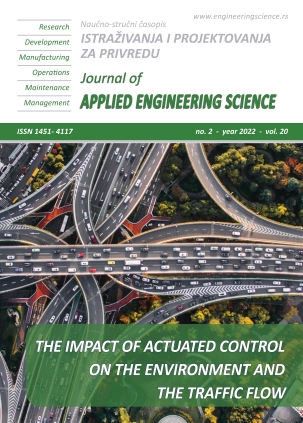RESEARCH OF TEMPERATURE DISTRIBUTION IN THE PROCESS OF THERMO-FRICTIONAL CUTTING OF TITANIUM ALLOY TI-5553
Abstract
This article presents the results of studying the temperature distribution in the process of thermo-frictional cutting of titanium alloy Ti-5553. The process was simulated using the Machining module of the DEFORM 3D software package based on the finite element method. It was found that when cutting off the titanium alloy Ti-5553, depending on the geometry of the circular saw, the temperature in the "disk-workpiece" contact zone reached T = 800 ÷ 1130 °C, and its propagation into the depth of the workpiece was 0.66 ÷ 0.96 mm. The optimal geometry of a circular saw for cutting off titanium alloy Ti-5553: L1 = 18 mm, L2 = 14 mm, в = 2 mm.
The research was carried out within the framework of the grant № AP09562459.
References
Afonkin M.G., Zvyagin V.B. (2011) Production of workpieces in mechanical engineering. - 2nd ed., add. and revised SPb.: Polytechnic. - 380 p.
Ilyin A.A., Kolachev B.A., Polkin I.S. (2009) Titanium alloys. Composition, structure, properties. Directory. –M.: VILS-MATI.-520 p.
Arrazola P.J., Garay A., Iriarte L.M., Armendia M., Marya S., Le Maîtrec F. (2009) Machinability of titanium alloys (Ti6Al4V and Ti555. 3) / Arrazola P-J, et al. // Journal of Materials Processing Technology. - №209(5). - P.2223–2230. https://doi.org/10.1016/j.jmatprotec.2008.06.020
Ezugwu E., Wang Z. Titanium alloys and their machinability-a review (1997) Journal of Materials Processing Technology. -№68(3). - р. 262–274. http://citeseerx.ist.psu.edu/viewdoc/download?doi=10.1.1.463.938&rep=rep1&type=pdf
Dudak N., Itybaeva G., Mussina Z., Abishev K., Mukanov R. and etc. (2017) Hole Machining Based on Using an Incisive Built-Up Reamer // International Journal of Precision Engineering and Manufacturing, Volume 18, Issue 10, Pages 1425-1432. https://doi.org/10.1007/s12541-017-0170-9
Nag S. et al. (2009) Elemental partitioning between α and β phases in the Ti–5Al–5Mo–5V–3Cr–0.5 Fe (Ti-5553) alloy/Philos Mag. - №89(6), -р. 535–552.
Wagner , Baili M., Dessein G. (2015) The Relationship Between The Cutting Speed, Tool Wear, And Chip Formation During Ti-5553 Dry Cutting/ The International Journal of Advanced Manufacturing Technology, 2015. - Volume 76. – p. 893-912.
Zinoviev V.E. (1989) Thermophysical properties of metals at high temperatures. Directory. -M.: Metallurgy. - 486 p.
Balgabekov, T.K., Baissanov, S.O., Issin, D.K., Zholdubayeva Zh.D., Akashev А.Z., Baissanov, A.S., Issin, B.D. (2014) Studying properties of carbonaceous reducers and process of forming primary titanium slags / Metalurgija, 53(4), стр. 581–584.
Gospodinov D., Ferdinandov N., Dimitrov S. (2016) Classification, properties and application of titanium and its alloys / Proceedings of University Of Ruse - Volume 55.-Book 2.-Р.27-32.
Kosova N., Sachkov V., Kurzina I., Pichugina A., Vladimirov A., Kazantseva L., Sachkova A. (2016) The preparation of the Ti-Al alloys based on intermetallic phases/ //IOP Conf. Series: Materials Science and Engineering. – Vol. 112. - P.1-5.
Veeck S., Lee D., Boyer R., Briggs R. (2004) The microstructure and properties of cast titanium alloy Ti-5553 were evaluated in a joint program by Howmet and Boeing. / Advanced Materials & Processes. Volume 162, Issue 10. - Р. 47-49.
Illarionov A.G., Popov A.A. (2014) Technological and operational properties of titanium alloys: a tutorial. - Yekaterinburg: Publishing House of Ural University. - 137 p.
Ermolaev V.K. (2018) Grinding of titanium alloy parts. Rhythm of mechanical engineering. -No. 5. -pp.18-24.
Sherov K.T., Donenbayev B.S., Mazdubay A.V. (2017) Thermofriction method of cutting metal blanks with cooling and the design of a circular saw // Patent of the Republic of Kazakhstan No. 31934. Bull. No 6..
Sherov K.T., Ainabekova S.S., Mazdubai A.V., Gabdysalyk R. et al. (2020) Circular saw / Patent No. 4592 RK for a useful model. Bul. № 1.
Sherov K.T., Mazdubai A.V., Musaev M.M. and other (2017) Device for thermos-frictional cutting of metal blanks / Patent No. 2165 RK for a useful model. Bul. № 9.
Katyshev S.I. (2018) Application of the "DEFORM 3D" software package for modeling the milling process // Novosibirsk: SibAK Experimental and theoretical research in modern science: a collection of articles based on the materials of the XXVII int. scientific-practical Conf., No. 18 (26). - pp. 14-22.
Kadyrov A., Zhunusbekova Zh., Ganyukov A., Kadyrova I., Kukesheva A. (2021) General Characteristics for Loading the Working Elements of Drilling and Milling Machines when Moving in the Clay Solution // Communications-Scientific Letters of the University of Zilina.- Vol.23, no.2.-P.B97-B105. DOI: https://doi.org/10.26552/com.C.2021.2.B97-B105
Sherov K., Sikhimbayev M., Mazdubay A., Sherov A., Rakishev A., Mussaev M., Donenbayev B., Bayzhabaginova G. (2017) The research of the temperature impact in tool-workpiece contact on the quality of the cut at thermofrictional cutting. Mechanics and Mechanical Engineering, Volume 21, Issue 3, 755-762. http://www.kdm.p.lodz.pl/mme-art.html
Sherov K.T., Sikhimbayev M.R., Sherov A.K., Mazdubay A.V., Rakishev A.K. et al. (2017) Matematical modeling of thermofrictional milling process using ANSYS WB software / Journal of Theoretical and Applied Mechanics, Sofia, Vol. 47, No. 2 - PP. 24-33. https://doi.org/10.1515/jtam-2017-0008
Sherov K.T., Sikhimbayev M.R., Nasad T.G., Absadykov B.N., Izotova A.S., Okimbayeva A.E., Кuanov I.S. (2020) The research of the steel cutting blade reliability for thermo-frictional processing // News of the National Academy of Sciences of the Republic of Kazakhstan. Series of geology and technical sciences. 2020. Volume 1, Number 439, P.122 – 130. https://doi.org/10.32014/2020.2518-170X.15
Bydanov V.V., Alekseev V.P. (2015) Optimization of processing conditions for difficult-to-machine material on the basis of the developed simulation model of the milling process in the CAE-system DEFORM. Bulletin of the Samara Scientific Center of the Russian Academy of Sciences, Vol. 17, No. 6 (3). - pp. 612-617.
Khaymovich A.I., Balyakin A.V., Kondratev A.I. (2014) Methodology of rheological material properties phenoinenological modeling at high speed cutting by reverse analysis // Research Journal of Applied Sciences. 9(11). - P. 753-760.
Rakishev A., Sagitov A., Donenbaev B., Sherov K., Tussupova S., Smakova N., Mazdubay A., Imanbaev Ye. Calculation of the multi-blade rotary-friction tool’s cutting cupped cutter to strength in the ANSYS WB surrounding / Journal of Applied Engineering Science, 18(2020)4, 643 - 648. https://doi.org/10.5937/jaes0-24328

